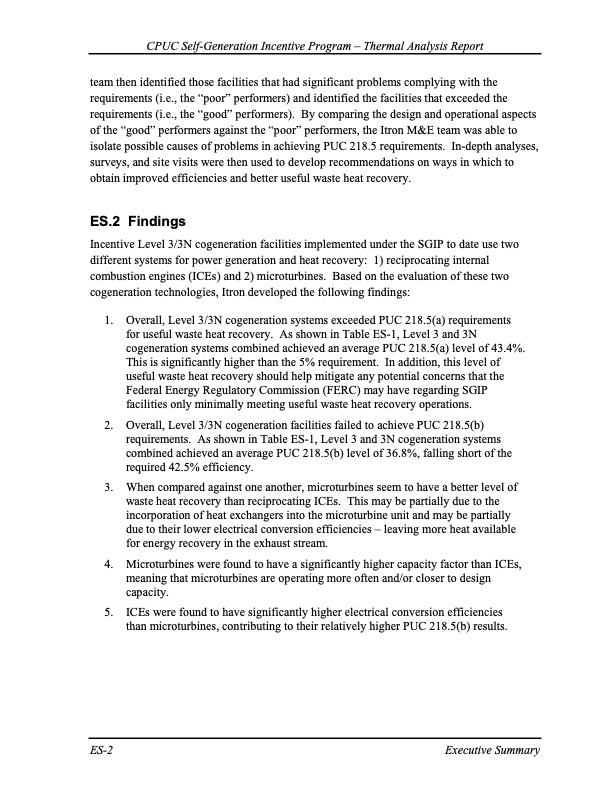
PDF Publication Title:
Text from PDF Page: 006
CPUC Self-Generation Incentive Program – Thermal Analysis Report team then identified those facilities that had significant problems complying with the requirements (i.e., the “poor” performers) and identified the facilities that exceeded the requirements (i.e., the “good” performers). By comparing the design and operational aspects of the “good” performers against the “poor” performers, the Itron M&E team was able to isolate possible causes of problems in achieving PUC 218.5 requirements. In-depth analyses, surveys, and site visits were then used to develop recommendations on ways in which to obtain improved efficiencies and better useful waste heat recovery. ES.2 Findings Incentive Level 3/3N cogeneration facilities implemented under the SGIP to date use two different systems for power generation and heat recovery: 1) reciprocating internal combustion engines (ICEs) and 2) microturbines. Based on the evaluation of these two cogeneration technologies, Itron developed the following findings: 1. Overall, Level 3/3N cogeneration systems exceeded PUC 218.5(a) requirements for useful waste heat recovery. As shown in Table ES-1, Level 3 and 3N cogeneration systems combined achieved an average PUC 218.5(a) level of 43.4%. This is significantly higher than the 5% requirement. In addition, this level of useful waste heat recovery should help mitigate any potential concerns that the Federal Energy Regulatory Commission (FERC) may have regarding SGIP facilities only minimally meeting useful waste heat recovery operations. 2. Overall, Level 3/3N cogeneration facilities failed to achieve PUC 218.5(b) requirements. As shown in Table ES-1, Level 3 and 3N cogeneration systems combined achieved an average PUC 218.5(b) level of 36.8%, falling short of the required 42.5% efficiency. 3. When compared against one another, microturbines seem to have a better level of waste heat recovery than reciprocating ICEs. This may be partially due to the incorporation of heat exchangers into the microturbine unit and may be partially due to their lower electrical conversion efficiencies – leaving more heat available for energy recovery in the exhaust stream. 4. Microturbines were found to have a significantly higher capacity factor than ICEs, meaning that microturbines are operating more often and/or closer to design capacity. 5. ICEs were found to have significantly higher electrical conversion efficiencies than microturbines, contributing to their relatively higher PUC 218.5(b) results. ES-2 Executive SummaryPDF Image | In-Depth Analysis of Useful Waste Heat Recovery and Performance of Level 3/3N Systems

PDF Search Title:
In-Depth Analysis of Useful Waste Heat Recovery and Performance of Level 3/3N SystemsOriginal File Name Searched:
SGIP_ThermalAnalysisReport.pdfDIY PDF Search: Google It | Yahoo | Bing
Capstone Turbine and Microturbine: Capstone microturbines used and new surplus for sale listing More Info
Consulting and Strategy Services: Need help with Capstone Turbine, sizing systems, applications, or renewable energy strategy, we are here to assist More Info
Container Lumber Dry Kiln: Since 1991 developing and innovating dry kilns using standard shipping containers More Info
Supercritical CO2 Lumber Dry Kiln: Compact fast drying in 3 days or less for small amounts of wood and lumber drying More Info
BitCoin Mining: Bitcoin Mining and Cryptocurrency... More Info
Publications: Capstone Turbine publications for microturbine and distributed energy More Info
FileMaker Software for Renewable Energy Developing database software for the renewable energy industry More Info
CO2 Gas to Liquids On-Demand Production Cart Developing a supercritical CO2 to alcohol on-demand production system (via Nafion reverse fuel cell) More Info
Stranded Gas for low cost power Bitcoin Mining Using stranded gas for generators may provide breakthrough low power costs for cryptocurrency miners. More Info
| CONTACT TEL: 608-238-6001 Email: greg@globalmicroturbine.com | RSS | AMP |